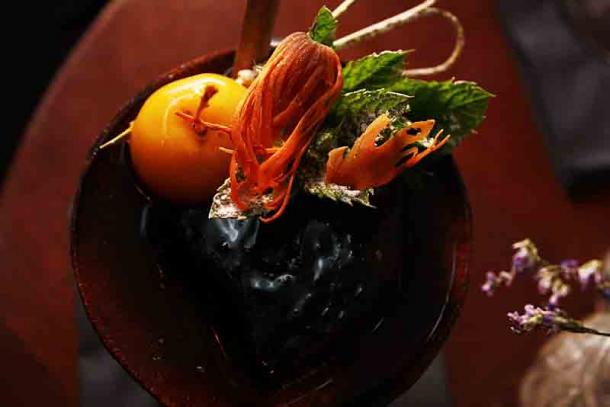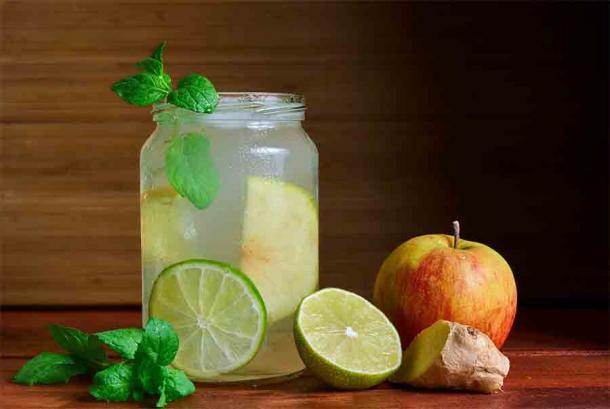Before Americans had sports drinks, switchel was the beverage of choice for rehydration. Also known as haymaker’s punch, harvest drink, harvest beer, and swanky, this is a refreshing drink that was popular a few hundred years ago.
Although it is largely forgotten in the world today, switchel was an exceedingly popular thirst quencher for American settlers from the late 1600s through the 1900s. It’s tangy, sweet, simple to make, thirst quenching, and energizing.
In its most basic form, switchel is just a blend of apple cider vinegar, water, ginger, and a sweetener. Each cook had their own particular recipe for switchel, depending on the ingredients available. Molasses is most commonly listed as the sweetener and it was generally used by New Englanders, but out on the frontier, settlers would often swap in honey instead, and down in the south, people used sorghum.
The exact origin of switchel is unclear, but a popular belief is that the Amish brought the idea over to America from Germany. Others say its roots are in the West Indies, China, or the Caribbean. But food historians would also mention that this type of beverage can be traced back to ancient times.
Homemade switchel. Source: zvon / Adobe Stock
Ancient Roots
In ancient Greece, for example, people drank a honey and vinegar tonic called oxymel mixed with herbs as medicine – an idea that was adopted by the Romans and remained popular until the Renaissance. Iranians have a traditional drink called sekanjabin combining honey or sugar with white vinegar, which they consume on hot afternoons. The ancient Romans also had a variation of a vinegar and water drink called posca, which was popular with their soldiers. Ancient Roman soldiers and possibly plebians turned to posca when they needed to quench their thirst or mask the taste of unpleasant water. Posca was sour wine or vinegar, mixed with water, and flavored with herbs like coriander or vinegar. The elites generally frowned upon this simple drink, but it was standard camp fare for the Roman Republican army.

Roman posca. CC by SA 2.0
A Haymaking Thirst Quencher
Traditionally, switchel has been linked with haymaking but it was so ubiquitous to life that it appears several times in literature. One of the earliest written references to switchel comes from a 1789 poem by Philip Freneau (the “Poet of the American Revolution”). In ‘On the Demolition of an Old College,’ Freneau claims that the non-alcoholic switchel could not have incited the destruction of a log building by students at Dartmouth College. He writes:
“Relent, relent! to accomplish such designs
Folks bred on college fare are much too weak;
For such attempts men drink your high-proof wines,
Not spiritless switchel and vile hogo drams,
Scarcely sufficient to digest your Greek—”
Laura Ingalls Wilder also mentions the consumption of switchel being helpful during haymaking in ‘ The Long Winter ’:
“Now the sun and the wind were hotter and Laura’s legs quivered while she made them trample the hay….She was thirsty, then she was thirstier, and then she was so thirsty that she could think of nothing else…Ma had sent them ginger-water. She had sweetened the cool well-water with sugar, flavored it with vinegar, and put in plenty of ginger to warm their stomachs so they could drink till they were not thirsty. Out of the fields, switchel was allegedly the drink of choice during the long, hot days of the second continental congress, but the founding fathers apparently preferred their beverage fortified with Rum.”

Switchel was a haymaking thirst quencher. Credit: Deb / Adobe Stock
A Touch of Rum
Speaking of rum, it wasn’t only the founding fathers who apparently added this oomph to their switchel. Several cooks also included it to their recipe or opted for whiskey, brandy, or hard cider. Oddly enough, switchel has even made its way into some bars today as a cocktail ingredient. Over the years, switchel recipes have also included lemon, maple syrup, mint, orange zest, berries, or cayenne pepper (as a cold cure).
Farmers used to say that switchel “quenches the thirst, clears the throat and nose of dirt and hay, provides a boost of energy, and keeps the body from getting sick.” From a health perspective, switchel is a more natural choice than a sugary sports drink. Molasses includes the electrolyte potassium, ginger is an anti-inflammatory, and apple cider vinegar provides microbial gut benefits.
Colonial farmers believed that drinking a hot drink while working in the sun was good for you because it would balance your body temperature. But since no one really wanted to drink a hot cup of tea on a hot day, they often opted for alcohol, or the ginger in switchel, to get the same warming sensation.

A cocktail made with switchel. CC by SA 2.0
An Alcohol Substitute
But why the vinegar? Some historians believe that the cider vinegar was also meant to act as an alcohol substitute. Others say that it worked in place of lemons, making switchel a substitute for lemonade in a region where gaining access to lemons was not easy.
The amount of each ingredient in a switchel recipe largely depended on personal tastes; people would often create the drink by adding small amounts of the ingredients until it tasted right to them. Since switchel was made for farmers, recipes for the drink were not usually added to the early American cookbooks that were destined for higher-class households.
Switchel may remind you of a tart soda or kombucha, or it may be something completely new to you. It is tangy, a little spicy, and a little sweet, but overall very refreshing!
Top image: A Farmer with a drink. Source: Cherries / Adobe Stock
By Alicia McDermott
Related posts:
Views: 0
 RSS Feed
RSS Feed
















 March 22nd, 2021
March 22nd, 2021  Awake Goy
Awake Goy 
 Posted in
Posted in  Tags:
Tags: 
















